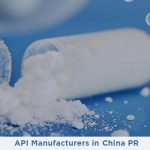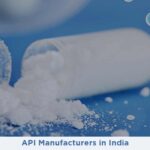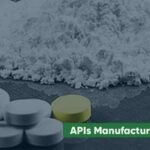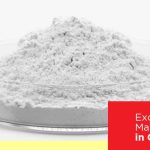The Active Pharmaceutical Ingredients (APIs) are the essential, biologically active compounds in every pharmaceutical products which produce therapeutic effects. Active pharmaceutical ingredients (APIs) are used in combination with other ingredients to diagnose, cure, mitigate, and treat diseases. They serve as the foundation of pharmaceutical development and manufacturing.
All the medications we use are made of both the API (the major component which is a chemically and biologically active moiety), and the excipients (the chemically inactive component like lactulose, mineral oil, that adds color, volume, binding, flavor or sweetening, or as preservatives). Excipients helps the delivery of the APIs to the required part of the body.
An intermediate is the chemical compound which is in the process of becoming an API from a raw material. Both natural and synthetic organic chemistry yield Bulk Process Intermediates (BPI). The intermediates undergo complex chemical reaction (with controlled temperature and pressure) and purification process to create Active Pharmaceutical Ingredients (APIs).
Examples of Active Pharmaceutical Ingredients (APIs) formed from bulk process intermediates include Acetaminophen which comes from coal tar bulk process intermediates, Aspirin which is made from bulk process intermediate phenol and salicylic acid, and Insulin, made from intermediates like proinsulin.
Some of the most used Active Pharmaceutical Ingredients (APIs) include Ibuprofen, Paracetamol, Aspirin, Cetirizine, Amoxicillin, Hydrochlorothiazide, Atorvastatin, Metformin, Lisinopril, and Omeprazole.
Most of the Active Pharmaceutical Ingredients (APIs) are produced in China, India, USA and Europe.
Major authorities like the FDA (Food and Drug Administration), EMA (European Medicines Agency), and WHO (World Health Organization), GMP (Good Manufacturing Practices), provide the regulatory standards to test the quality, safety, and efficacy of Active Pharmaceutical Ingredients (APIs).
Sources of APIs
Active Pharmaceutical Ingredient (API) can be of natural (plants, animals, and minerals) or synthetic chemical-based active compounds.
Natural or Biological APIs:
Natural or Biological APIs are derived from living organisms, which includes proteins, nucleic acids, enzymes, peptides, and monoclonal antibodies using biotechnology and genetic engineering. Bacteria, yeast, or mammalian cells are all potential sources of biological ingredients.
Examples are vaccines, insulin. Humira, which inhibits TNF-alpha and are used to treat rheumatoid arthritis and Crohn’s disease, uses biologic API (Adalimumab). Bevacizumab is the biological API in Avastin, a drug which is used to treat cancer.
The global demand for microbial-based manufacturing of recombinants, peptide hormones and vaccine have increased significantly in recent years. Top biopharmaceutical companies such as AbbVie, Bayer, Biocon, Eli Lilly, GlaxoSmithKline, Merck, Sanofi, formulate products through using microbial fermentation.
Synthetic APIs:
Synthetic APIs are chemically synthesized with the raw materials undergoing chain of complex reactions to give the final product. These products are more precise in chemical compositions.
Stages of API Formulation
The manufacturing of Active Pharmaceutical Ingredients start from the sourcing of raw materials, chemical synthesis or fermentation (for biological APIs) through complex reactions. After synthesis, the product is purified to remove impurities, and by-products.
The already purified API is crystallized and dried to obtain a stable, usable form used for pharmaceutical manufacturing. Quality control and testing using analytical methods (HPLC (High-Performance Liquid Chromatography) and Mass Spectrometry) to test the quality, potency, stability, and purity is carried out before packaging the API.
Types of Active Pharmaceutical Ingredients (APIs)
- Based on chemical size, Active Pharmaceutical Ingredients (APIs) can be classified into small molecule APIs and large molecule APIs.
Small Molecule APIs:
They have simple chemical structure and low molecular weight (mostly less than 900 Daltons). Produced through chemical synthesis using, they are formulated mostly as tablet or capsule.
These type of Active Pharmaceutical Ingredients (APIs) are easier to produce, and more stable (stored at room temperature), making it the most widely used. The body also absorbs them easier. They are used in therapeutic classes such as enzyme Inhibitors (to treat HIV), kinase inhibitors (cancer treatment), and receptor agonists/antagonists (like beta-blockers for hypertension)
Examples include Paracetamol, Aspirin, Ibuprofen, Metformin, Atorvastatin, Amoxicillin and Penicillin.
Large Molecule APIs or Biologics APIs:
Large Molecule APIs or biologics are complex biological structure derived from living organisms like bacteria, yeast, or mammalian cells, with high molecular weight (thousands to millions of Daltons). They are manufactured through biotechnology (cell cultures, recombinant DNA technology).
They are not orally bioavailable, hence they are formulated as injections, or infusion. However, they are more specific and can target specific molecules or cells
Large molecule APIs are used to treat chronic diseases, cancers, and immune disorders, and include Monoclonal Antibodies, Vaccines, Insulin, and Gene Therapies.
Peptide APIs, also a class of large molecule drugs are made from short chains of amino acids linked by peptide bonds. They are used for precision and targeted treatment, as in cancer, diabetes.
Gene therapies are used to treat genetic disorders by replacing or fixing faulty genes. Monoclonal antibodies are antibodies engineered to target specific antigens, in treating cancers, autoimmune diseases, and certain viral infections. Vaccines stimulate the immune system to prevent disease.
- Active Pharmaceutical Ingredients (APIs) can also be classified into Generic APIs or Branded APIs.
Branded APIs or Innovative APIs:
Manufactured by pharmaceutical companies with exclusive patents. The medication undergo numerous research and clinical trials before approval. They are usually costly due to high R&D costs and exclusivity rights.
Generic APIs:
Once the patent of a drug expires, other manufacturers can produce generic versions utilising the same API. A generic API is chemically identical to the API obtained in a brand-name drug. However, the manufacturing process, method of formulation, and the inactive ingredients (excipients) may differ from the branded API.
Major Active Pharmaceutical Ingredients (APIs) Chemicals
- Shikimic acid: Used for the synthesis of chiral buildings block. Used in Oseltamivir, a shiikimic acid-based antiviral drug used to treat influenza (A, B).
- Clavulanic acid: A medication used to fight the bacterial resistance against β-lactam antibiotics. It is included under the essential medicinal list of the World Health Organization.
- Cephalosporin (7-aminocepahlosporanic acid): Obtained from cephalosporin. Some of the cephalosporin-based drugs include ceftriaxone, cefotaxime, cefuroxime, and cefdinir.
- Pregabalin: An anticonvulsant used to treat seizure disorders, fibromyalgia, and neuropathic pain
- Ectoine: The primary metabolite made when microorganisms grow in a medium with a high salt concentration. Used in cosmetics and pharmaceuticals.
- Rifampicin: Antibiotic with a wide range of activity against bacteria, eukaryotes, and viruses.
- Succinic acid or butanedioic acid or amber acid: A common metabolite in plants, animals, and microorganisms used as sedatives, antispasmers, antirheoters, contraceptives, inhibitor of potassium ions, and antioxidants.
Therapeutic Classes of Pharmaceutical Active Ingredients
- Analgesics: Acetaminophen, Aspirin, Phenazone, Sodium Salicylate, Meptazinol HCl, Diclofenac Sodium, Buprenorphine HCl
- Antihistamine: Chlorpheniramine, Levocetirizine, Fexofenadine, Hydroxyzine, Pheniramine Maleate.
- Anesthetics: Levobupivacaine, Lidocaine, Bupivacaine, Mepivacaine, Ropivacaine, Prilocaine, Benzocaine
- Antibiotics: Doxycycline, Erythromycin, Amoxicillin, Mupirocin, Piperacillin, Cefadroxil, Tedizolin.
- Anticancer agents: Palbociclib, Ibrutinib, Enzalutamide, Ribociclb, Pemetrexed Disodium
- Antidiabetics: Metformin HCl, Glimepiride, Glipizide, Alogliptin, Sitagliptin, Pioglitazone, Saxagliptin.
- Cardiovascular agents: Amlodipine Maleate, Clopidogrel, Levosimendan, Dopamine HCl, Trimetazidine HCl
- Antipsychotic drugs: Chlorpromazine, Clozapine, Aripiprazole, Asenapine, Olanzapine, Quetiapine, Ziprasidone, Lurasidone
- Antidepressants: Sertraline, Amitriptyline, Citalopram, Escitalopram, Milnacipran, Clomipramine, Doxepin, Paroxetine, Venlafaxine
- Antifungal: Miconazole, Terbinafine, Itraconazole, Clotrimazole, Fluconazol, Piroctone Olamine
- Vitamins: Ascorbic Acid, Folic Acid, Benfotiamine, Niacinamide, Calcium Pantothenate, Hydroxocobalamin, Alfacalcidiol
References:
- https://www.researchgate.net/publication/357795938_Active_pharmaceutical_ingredient_API_chemicals_a_critical_review_of_current_biotechnological_approaches
- https://dolphinpharma.com/role-of-active-pharmaceutical-ingredient/
- https://www.arborpharmchem.com/examples-of-api-in-pharma/
- https://newedgeoverseas.com/blog/11-therapeutic-categories-of-pharmaceutical-apis-and-their-uses/
- https://bio-synth.in/blogs/types-of-apis-small-molecules-peptides-biologics/
- https://contractlaboratory.com/pharmaceutical-drug-development-small-molecules-large-molecules-2/







